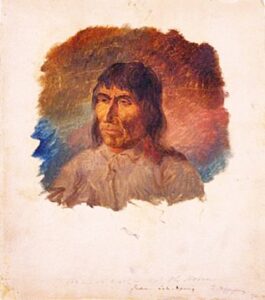North Bay renames beach to Shaabegiizhig Jiibiik in act of reconciliation

By Kelly Anne Smith
NORTH BAY— “It is a good gesture to reconciliation and land acknowledgement,” says Nipissing First Nation Chief Scott McLeod on the renaming of a popular beach in North Bay to Shaabegiizhig Jiibiik. The new name references Chief Shaabegiizhig, a signatory of the Robinson-Huron Treaty of 1850.
North Bay City Council approved the renaming of Marathon Beach on May 3. The colonialised spelling is Shabogesic Beach.
Nipissing First Nation Chief McLeod says the underlying title to these lands belong to Indigenous people and it’s good to reflect that in the names of public spaces.
“I think North Bay has shown some initiative with allowing Indigenous communities to reclaim their presence within what is now known as municipal land.”
Chief McLeod is a direct descendant of Chief Shaabegiizhig. He says it is likely he was in the area of Shaabgiizhig Jiibiik.
“The lake itself was utilized a lot more back in those times. And for different reasons than we have today. La Vase River was used frequently as a means of transportation. A lot of those beach areas were used for outposts or campsites by the Nipissing Peoples for millennia,” explains Chief McLeod. “I think it’s important to realize that all of North Bay and Callander were home lands to our people throughout the centuries. So, it’s not just about Chief Shaabgiizhig. It’s about our inherent right. It’s about our Treaty that we signed to protect those inherent rights and it’s about the people that came before him and that came after him… The reason why he is a good namesake is because by signing the Treaty, he made that agreement on behalf of our nation to protect those inherent rights and to protect our culture and identity.”
Nipissing First Nation Councillor Joan McLeod Shabogesic is pleased with the renaming.
“I think it’s about time that they gave this man back his due.”
She is passionate about the rich history of Nipissing and wrote a biography for Chief Shaabgiizhig.
“He was at the forefront. He has letters as far back as 1845, where he is requesting a reserve be set aside for his people,” she recalls. “He knew that the changes were coming. A lot of people have this idea that people here wouldn’t know what was happening in the world. They say there was a moccasin telegraph. They heard about Sitting Bull and what was happening in the states. They said, ‘No, we have to protect ourselves.'”
McLeod Shabogesic says one of the primary reasons why any of the chiefs would have signed that Treaty was to ensure they were recognized. The biography states that Chief Michel Shabogesic and Penasse and O’Jeek, his principal men, agreed to the Robinson-Huron Treaty request in May 1848. They used the Deer, Elk, Moose, Fish, and Marten to sign the letter. The animals are dodems or clans. Traditionally, dodems denote a person’s role in society.
McLeod Shabogesic adds that a lot of the culture around the dodem has been lost. She says that prior to the Indian Act, chiefs were selected based on dodem.
“I think each of our nations should be looking for these historical sources that identify our men of that day, about ninety to a hundred years ago. A lot of that has been lost to colonization. I know from my research that the dodems were a structure when we did our Feast for the Dead and we selected our chief. Each of the families had a chief. Then those chiefs sat down every 10 years or so at a Feast for the Dead and decided who the Nipissing Chief – the primary chief – would be. And it was only the Nipissing Chief who would decide who the main spokesperson would be.”
Shaabgiizhig was the pre-confederation chief, points out McLeod Shabogesic.
“He would probably be the last one that was selected in that manner, under the dodems.”
Heron or Crane was Chief Shaabgiizhig’s dodem. McLeod Shabogesic says the great blue heron has a big presence on Lake Nipissing.
“The Heron or the Crane clan is our chief clan. There might be some debate he was signing with the Heron. That’s not really his clan that he was born with. It might be he was signing the Crane because he was the chief.”
McLeod Shabogesic will be consulting with the Nibisiing Language Committee for the proper spelling for Chief Shaabgiizhig, whose name meant ‘against the heaven.’
McLeod Shabogesic works to get curriculum developed so youth can know their families and know who their ancestors are. When she writes a biography, she calls them Nipissing Notables and often includes the names of community citizens for them to understand who they descended from.
Shabogesic descendants are identified by the surnames Shabogesic, McLeod, Beaucage, Commanda, Goulais, Penasse, O’Jeek, Fisher, Allaire, Bellaire, Young, Couch, Couchie, Saulis, Lewis, Otowadjiwan, Bellefeuille, Faubert, Fischer, Laronde, Martel, Lem, Head, Moon, Sawyer, Cornthwaite, Ray, Tierney, Bourassa, and Gagne.
Nipissing First Nation Chief and Council will consult on the change to Shaabegiizhig Jiibiik before approving the renaming, says McLeod Shabogesic.
“There are other trails and canoe routes that North Bay City Council is looking at renaming. Those are things that Nipissing First Nation is looking at too.”

